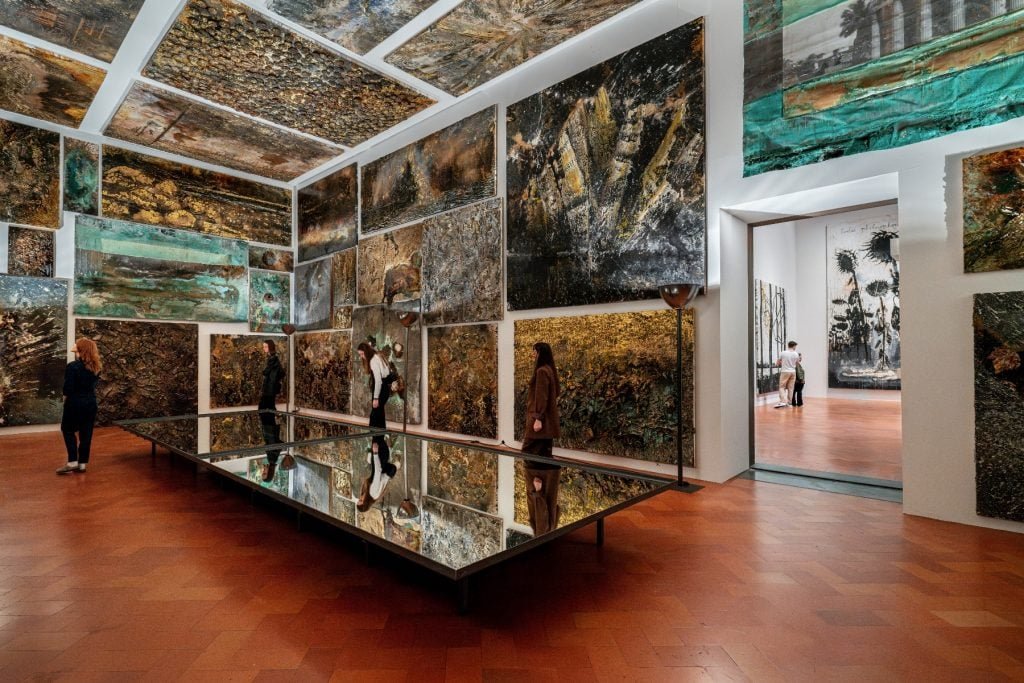Did you know all 200,000 tickets for the Vermeer exhibition at the Rijksmuseum sold out within two days? If you did manage to snag some tickets, you’ll get to see Vermeer’s works up close in a way that’s never been done before.
If you didn’t manage to get tickets, don’t despair! Keep reading to learn more about the show’s highlights and where you can see the paintings after the show wraps in June.
Vermeer Exhibition Highlights & Where to Find Them After the Rijksmuseum Show
Currently showing at the Rijksmuseum in Amsterdam, the Vermeer exhibition is a must-see for art lovers and historians alike. The exhibition is the largest Vermeer show ever. The Rijksmuseum collaborated with 14 museums and private collectors from seven countries to make this once-in-a-lifetime show a reality!
You probably know Girl with the Pearl Earring, but do you know about other highlights from Vermeer’s oeuvre? There are scandals and secrets contained within Vermeer’s works if you know where to look.
If you’ve got tickets to the Rijksmuseum show, you can read up on some of the stories before you go.
Didn’t get tickets? Learn about the highlights and find out where you can visit these masterpieces once the show wraps.
Girl with a Pearl Earring, 1664–67
📍Mauritshuis, The Hague

Girl with a Pearl Earring depicts a young woman with a blue and yellow turban and an oversized pearl earring in her left ear. She looks over her left shoulder, her eyes meeting the viewer’s gaze. The subject’s mysterious expression has led to much speculation about the painting’s meaning.
Still, it is generally believed to be a portrait of a young woman, possibly a servant or a model, rather than an idealized or fictional character. This painting will be at the museum until March 30th, when it will return to its home at the Mauritshuis.
From March 30th, see the Girl with a Pearl Earring at the Mauritshuis.
Girl Reading a Letter at an Open Window, 1657-59
📍Gemäldegalerie Alte Meister, Dresden

The Gemäldegalerie Alte Meister in Dresden undertook an incredible two-and-a-half-year project to uncover a hidden image within Girl Reading a Letter at an Open Window.
The painting, which depicts a woman reading in a sun-drenched room, took on a new meaning when restorers unveiled the painting of Cupid in the background. The work now reads as an overt romantic tale with the re-introduction of Cupid.
Scholars believed the woman was most likely reading a love letter, but without Cupid, this subtext was lost to audiences until now. The restorers used medical scalpels and a 120x magnification microscope to chip away at layers of paint rather than removing the varnish.
This painstaking process took years, with only a few millimeters squared revealed each day. You’ll see the painting now as it was originally intended – with the messenger of love looking on as the young woman reads her letter.
Mistress and Maid, c. 1666–67
📍The Frick Collection, New York
The Mistress and Maid is one of the three pieces that has crossed the seas from the Frick Collection to be part of the exhibition. It’s one of Vermeer’s largest paintings, and the Frick Gallery believes it was commissioned to hang over a patron’s mantel.
The maid hands a letter to her employer, who is shocked enough to drop her pen and raise her hands to her face. Audiences of the time would have eaten up the drama and intrigue of a shocking letter, as this was a common genre scene at the time.
The Lacemaker, 1669-70
📍Musée du Louvre, Paris
The Lacemaker is one of Vermeer’s smallest paintings. Although tiny, the canvas is nearly bursting with details. The lacemaker is focused totally on her painstaking task of winding bobbins over and under each other to create handmade lace.
You’ll notice Vermeer’s mastery of color and light here – pay close attention to how he’s used red and white to skillfully depict the thin threads that the lacemaker uses to create her works.
The Procuress, 1656
📍Gemäldegalerie Alte Meister, Dresden
Here, Vermeer depicts a transaction between a madam, customers, and a lady of the night. His exquisite details bring the painting to life. Unlike other images at the time, he depicts the madam, or procuress, as less actively involved in the exchange. She peers out at the interactions from behind, clad in all black.
The prostitute is draped in an oriental rug which had become popular in the Netherlands in the 17th century, although the vivid blues of the rug have faded to a grey color after years of light exposure.
Pay attention to the man standing on the left of the canvas. In his hand is an expensive Venetian beer glass, and his clothing is of fine lace and velvet – all signs that these brothel customers were of the upper-middle class. What’s quite unique is that this figure stares out at us, looping us into the forbidden fun of what he and his friend are doing.
This mysterious painting will return to the Germäldegalerie Alte Meister once the show ends.
View of Delft, 1660-61
📍Mauritshuis, The Hague

View of Delft features a panoramic view of Vermeer’s hometown. The painting depicts a tranquil, calm view of the city seen from the South. The usually bustling trade city is shown here in a quiet moment.
You’ll love the attention to detail, such as the voluminous clouds and reflections in the water. The painting’s composition is harmonious, with a third of the canvas taken up by the sky, the city, and the water.
Woman Holding a Balance, ca. 1662–65
📍National Gallery of Art, Washington
Woman Holding a Balance is coming from the National Gallery of Art in the US. You’ll see a woman standing at a table holding scales in her right hand. Behind her is a painting of the Last Judgment. Beside her are trappings of wealth – glowing blue fabric, pearls, and a gold chain.
The sunlight streams through the window, highlighting her as she works. Because of the juxtaposition of the Last Judgment, expensive objects, and the woman’s serene expression, scholars believe this work served as a warning for Vermeer’s audience.
Vermeer uses these images, which would have been clear to his audience, to warn them to “weigh their sins” and approach their lives thoughtfully to lead virtuous Christian lives. The painting reminds Vermeer’s contemporaries to live lives of moderation – and not to get distracted by earthly treasures such as pearls and gold.
A Young Woman seated at a Virginal, c. 1670–72
📍The National Gallery, London
This luminous painting is one of Vermeer’s later works. Audiences of his time would have recognized that the woman was looking out at her potential suitor.
Music-making appears as a metaphor for courtship across Vermeer’s oeuvre. Here you can see from her intricately curled hair decorated with pearls that she would have been a lady of middle to upper-class status, sharing a sweet moment with her beau.
A Young Woman seated at a Virginal will return to London’s National Gallery after the show.
Or See the Show From Home…
Don’t want to wait? You can check out the exhibition from home. The Rijksmuseum put together a stunning digital exhibition, Closer to Vermeer. On their site, you can look at every single painting in the Vermeer show, with the option to listen to audio commentary from Stephen Fry.
Who Was Johannes Vermeer
Johannes Vermeer (1632-1675) was an artist based in Delft, the Netherlands. While he’s world famous now, he died relatively unknown and in debt.
His oeuvre is small – with just 35 paintings surviving to this day. His work is notorious for its bright colors, exquisite depictions of light and shadow, and domestic subject matter.
Vermeer’s Technique

When you look at a Vermeer painting, you may feel you’re in the room with his subjects. His super realistic depictions of people engaged in everyday activities feel intimate. So, how did he portray his subjects so realistically?
Art historians used to believe that he painstakingly painted his works and took a long time with each piece. However, new x-rays and research show that his underpaintings were made quickly – perhaps in a matter of a week or two instead of months at a time.
Using a larger brush, he would build up underlayers with broad strokes of paint. When the underlayers dried, he would build up layers of paint to create luminous, almost-glowing figures and objects.
Vermeer’s focus was on light and shadow when building up the underlayers. He would then begin to refine color and shading with the upper layers.

Researchers used 3D digital microscopes to analyze his working methods. He would also use glazes to build his subjects’ lifelike texture.
For example, in his masterpiece Girl with the Pearl Earring, he painted the pearl after painting the rest of the woman’s face, allowing glazed layers to shine through the pearl to give it a lifelike quality.
Vermeer used pigments to create his paintings that he would have mixed himself. He made his own vivid blacks by mixing different charcoal blends.
As many artists did at the time, he also used Weld and Indigo, two plant-based pigments to create vivid blues and yellows. Some of his works used lapis lazuli to create vivid blues. Historians can tell that those works would have been commissioned by a wealthy patron since lapis lazuli was so expensive at the time.
Vermeer’s Legacy
Scholars are still not in agreement on how many paintings Vermeer created. The National Gallery in Washington believes it has verified 34 paintings. The Rijksmuseum believes there are 35.
28 of his surviving works will be on show at the Rijksmuseum. Collectors began to value Vermeer’s work in the 1920s. At this point, many American collectors began to buy up Vermeer paintings from Europeans at relatively low prices.
Because of this, some of his works have only been displayed in the United States and have rarely left the country. Until this Rijksmuseum show, the biggest show of his works took place in 1994 at the National Gallery of Art in Washington, with 21 of his paintings.
A Homecoming: What Makes The Rijksmuseum Vermeer Exhibition Unique

The Rijksmuseum Vermeer exhibition is a collaboration between museums and collectors worldwide. Pieces that have never been shown publicly in the Netherlands have joined paintings that are already in the country.
Three paintings from the Frick Collection in New York City left the US for the first time in over 100 years for the show. The Frick Collection is renovating, and Rijksmuseum’s curators seized the opportunity.
Rijksmuseum’s general director, Taco Dibbits, told journalists and art critics that they realized this was the chance of a lifetime, saying, “it’s now or never”.
Pieter Roelofs, Head of Painting and Sculpture at the Rijksmuseum, told the Dutch newspaper Het Parool, ‘Homecoming’ was the magic word.
There was a sensitivity to that among the Americans. Like us, they think Vermeer needs to be introduced to a new generation. The [previous] Vermeer exhibition isn’t something you will have seen if you’re under forty.”
Explore the Rijksmueum’s Other Treasures
If you didn’t get tickets and you’re visiting Amsterdam, there’s still plenty to see. The Rijksmuseum has an enormous collection. From ornate costumes to furniture, to paintings from famous artists, you don’t want to miss this opportunity to explore when you visit Amsterdam.
Be sure to check out the many must-see highlights at the Rijksmuseum, with or without a Vermeer ticket!

